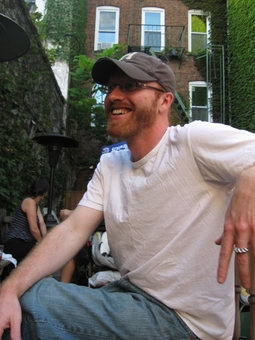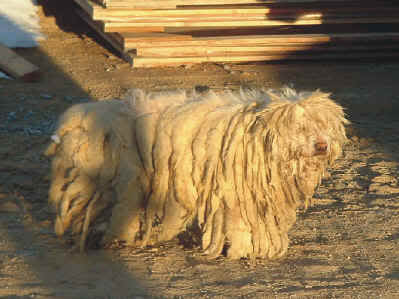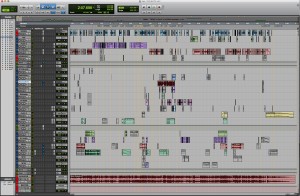
When hundreds of snow geese landed in and subsequently died from Berkeley Pit’s toxic water, some of the microbes the geese carried found a home in the Butte, Montana lake and started soaking up the lake’s toxins. Bioremediation, however, isn’t the subject of Radiolab senior producer Soren Wheeler’s story, “Even the worst laid plans?” Instead, Wheeler says, as in all Radiolab pieces, the show’s goal is to deliver “awe.” In 2011, the MacArthur Foundation awarded Radiolab’s co-host and producer Jad Abumrad a half-million dollar “genius” grant in recognition of the show’s “engaging audio explorations of scientific and philosophical questions.” But Radiolab is far from a one-man show created by a genius toiling alone in the studio.
Here, Soren Wheeler tells Robert Frederick and Corinna Wu the story behind the story of the Berkeley Pit, revealing some of the inner workings of Radiolab’s style. (This interview has been edited for length and clarity.)
How much of this story did you know before you started?
I grew up not far away from Butte and the Berkeley Pit. It had kind of mythic proportions in the minds of the kids who grew up in my town.
Ten years ago or so, this piece came out in the local Butte newspaper about a dog [named Auditor] that had been living around the pit mining area. It looked like a shepherding dog, but with these yellowed, nasty dreads hanging all around it that covered its eyes. It looked like some kind of monster from the swamp. It lived around the pit area for 17 years. And this is the kind of landscape where walking on the soil or near the water will eat through rubber boots.
So I thought that was great: Here’s this crazy looking alien dog that seems to defy all expectations of how life should live. At the time I was doing a science writing master’s degree at Johns Hopkins, and I wrote one of my stories for that class about the dog. [See Wheeler’s 2007 story for Plenty magazine.]

That story just stuck with me so much and seemed to resonate with the people who read it that I just started digging more and more into Butte, looking at health problems, other things that had to do with the pit, all these horrible environmental catastrophes. Through doing that, I ended up interviewing Don and Andrea Stierle. I was sitting in their office, and they were telling me they look at microbes that live in the pit. And then they told me the story of the goose microbes. So I had reported out that whole story in my master’s thesis. As soon as I came to Radiolab, I was pitching that idea.
When you started pitching the idea to Radiolab, did you know that writer Edwin Dobb had already done an article for Discover magazine about the Stierles’ research?
The Discover magazine story was long out, I think. He talked about finding life in the pit, and he’d talked to Don and Andrea. He’s written more about Butte and the pit than just that, too. But none of that had the goose thing. Don and Andrea did not tell him the goose [microbe] bit of the story, which is why I decided to focus the Radiolab piece on it.
We could have done a lot of things. We could have done something about the dog, too. But the goose [story] just seemed to have this redemptive quality. It just felt like the way the whole story wraps at the end is what we wanted to go with.
Wheeler’s piece was one segment of a Radiolab show with the theme of “Oops!” Hear about one “oops” that didn’t make it to the show.

How did this story’s structure evolve?
I knew it would begin with Don and Andrea. The first thing I knew about them was that they saw each other and fell in love at first sight. They’re just this ridiculously cute couple. They moved from beautiful San Diego and ended up in Butte, Montana. I knew I wanted to start with them in a way that gives you a sense of two characters that are lovable ending up in a place where they don’t want to be. That becomes then a way of motivating you to care about the place they ended up.
Once you start imagining the place, the structure plays out pretty simply from there: you tell the history of Butte, you get up to the point where the pit was created—so you’re doing a little bit of chronology, you stare at the pit, and what you see raises a question of how it got there, and then you’re just following Don and Andrea’s story again with the weird twist with the geese—their story and the story of Butte kind of collide back together at the end.
I just told you the structure, but I’m not sure I told you much about how we came to that structure. I mean, with every piece we do, we try one thing; we chuck it out; we try another; we move this there; we move that there; but I think in this case the structure was not a big problem.
Wheeler emphasizes a common technique in radio: Cut interviews for emotion instead of for information. (Caution: Expletives used.)
And so how many interviews are we talking about here?
I must have done the initial interview with the Stierles sometime over Christmas when I was back home. And then that failed and I did a studio interview with them. There was an interview with Edwin Dobb. Then we also sent Barrett Golding to the pit…and I lined him up with the [three] scientists he’s talking to. And then I took Jad [Abumrad] into the studio.
Without “scene tape” and truly being there, Wheeler says the story would not have run.
How long did this story take to create, start to finish?
I was trying to make the story happen for at least three or four months. But once we have all the interviews done, and we’re actually trying to do production and scoring and story structure and tracking and all that kind of stuff, I would guess this one took at least a week or two for me, and then three or four days of Jad’s time.
Why have Jad as an audience member, as if we’re listening to you tell the story to Jad rather than you telling the audience directly?
I think the spirit of the show is about Jad and Robert [Krulwich] hearing things and reacting to them—things they don’t know about and things they can share with the other one. So the hope is that there’s something in attitude and in stance that comes across when it’s me telling my friend Jad about this crazy story I heard, rather than me telling the radio audience about what I heard. I use different words when I’m in a conversation than I do if I write out a script. I’m a better narrator when Jad’s in the room because I’m talking to him.
Also, Jad can play the role of the audience member who maybe has a question, and because I’m so steeped in the story I’m telling, or I know so much about it, I don’t realize there’s really a question. He can sort of pop in, and that other voice somehow invites the listener in more. It makes them feel like the narrator is someone who can be questioned, is a real person, is not just steamrolling past them with a bunch of information, and Jad is trying to be an advocate for the listener and not let things go on too long or too deep without understanding what is really going on.
One of Wheeler’s metaphors for making good radio: Tell the story like you’re at a cocktail party.
So nothing is scripted? Jad hadn’t heard the story before?
Right after I pitched the story, and they heard [the pitch] and liked it, I just took Jad in the studio and said, “OK, Butte is this crazy town that I grew up next to…” and told him the story. And we probably did that for an hour, just to get versions of me that feel relaxed and easy, and to get versions of him having heard none of this and knowing nothing.
I’ll bet if you took all the tape of Jad and me talking, you’d have a couple hours of tape. And if you collected all the things I said in that piece, you’d have a minute or two minutes.
Not a performance, not a conversation, but more of a hybrid: Hear one part of Wheeler and Abumrad’s interaction that is purposefully “amped up.”
[Part of the “amping” it up is] I want you to get excited about this story, and I want you to see how I was seeing it when I first heard it. When you want to tell a story, you’ve got to really want to bring people in. [In amping it up we were] capturing how I felt about it when I first heard it.
On telling the story as “exciting talkers.”
How do you go about picking the music and sound effects?
Occasionally in Radiolab pieces, Jad will actually compose something. In this case, there’s no written music. These were all bits of music that were found. The holy music was probably some 17th-century Gregorian chant thing. It’s all classical music that was grabbed and tweaked and played with.
It’s pretty aggressive in the way we take music and modify it and use it more as punctuation than as real accompaniment. We will bring it in, drop it out with a weird phase shift, crank a filter on it. There are moments where it gets drawn out, but it comes and goes. It gets pushed to the background and then dropped back forward. You might hear a piece of music at one point, and when you hear it later, it’s the same piece of music, but the key has been shifted because the mood is slightly different. You’ll feel the recall of an earlier emotion but in a different context.
When words and music dance together: The decline of Butte, in music.
There’s also a musicality to the back-and-forth. There are times when the voices become a rhythm, and [the voices are] another instrument in a little orchestra. It gives you more to play with. You can create a music with the words that matches the music you’re using underneath.
A music-with-words example: Using the words “and growing.”

In terms of the putting together of the sounds and the music and having them drop out in the right ways and rise up in the right ways and shimmer in the right ways…we’ll go back and forth and I’ll try some things and he’ll try some things, and we’ll talk about what works and what doesn’t. But watching Jad play with ProTools is a little like shooting hoops in the driveway with your mom, and Michael Jordan shows up: you feel inadequate and small.
Deconstructing a sound effect: The shimmer.
How do you choose when not to use music or sound effects?
There are points in the story where to add music and sound effects would be to overdo and overstate it, having it sound like chintzy, ‘40s radio drama. As soon as you start hearing about the geese, there’s no music after that. We could have put the sound of flapping wings as the geese landed or some kind of croak when they died. But that all felt like too much. The story had a power all its own—somehow more powerful when it’s just a person saying, ‘And the geese died.’ Sometimes the words have their own power and emotion that you don’t want to get in the way of.
Giving listeners a resting place: “A pillow for your brain.”
What did you leave out (or what got cut out) of the story?
I wanted to say a lot more about Butte and a lot more about the science, and we were just dialing that back when it was not working and going too slow.
Half the time, you start out with a story and you think you have this really sharp knife that you can threaten people with, and by the time you look into the details of the story, you’ve actually got yourself a plastic picnic knife that’s not scaring anybody because of all the qualifications and all the arguments. So any science journalist is always standing on this slope of possible qualifications that can just make it feel like your story doesn’t say anything at all.
The way we deal with that, maybe differently than other print journalists or other science journalists on the radio, is just to rejoice in the mystery or embrace the poetry. I don’t want to say we ignore those questions, but we kind of slide past them.
In concluding that the microbes were sort of a “present” from the geese, what was your intention? Did it surprise you that the online comments on this story include references to divine intervention?
One of things that’s unique about Radiolab is that it gets a lot of people listening who otherwise would scoff at science. We do a lot to bring in, not religious per se, but more spiritual, more musical things. We attract people who are not necessarily staunch, atheistic, scientific thinkers. We’re talking about science, but we don’t give you a full dig down on the technical details. But we also take science and treat it poetically, which is risky, risky business.
Selling awe: Tapping into the spot where religion lives.
Robert Frederick and Corinna Wu want to thank Soren Wheeler for providing a high-quality recording of his interview responses and recordings from the show.

Robert Frederick has created podcasts, radio pieces, videos, and written about science, mathematics, business, and education for a variety of outlets, including Science, Nature, and NPR.

Corinna Wu is a freelance science writer, editor, and producer based in the San Francisco Bay Area. Prior to becoming an independent journalist, she worked on the staffs of U.S. News & World Report, Science News, and the radio show Science Update. She also spent a year as a Knight Science Journalism Fellow at MIT studying neuroscience and engineering design. Follow Corinna on Twitter @ckwu.


